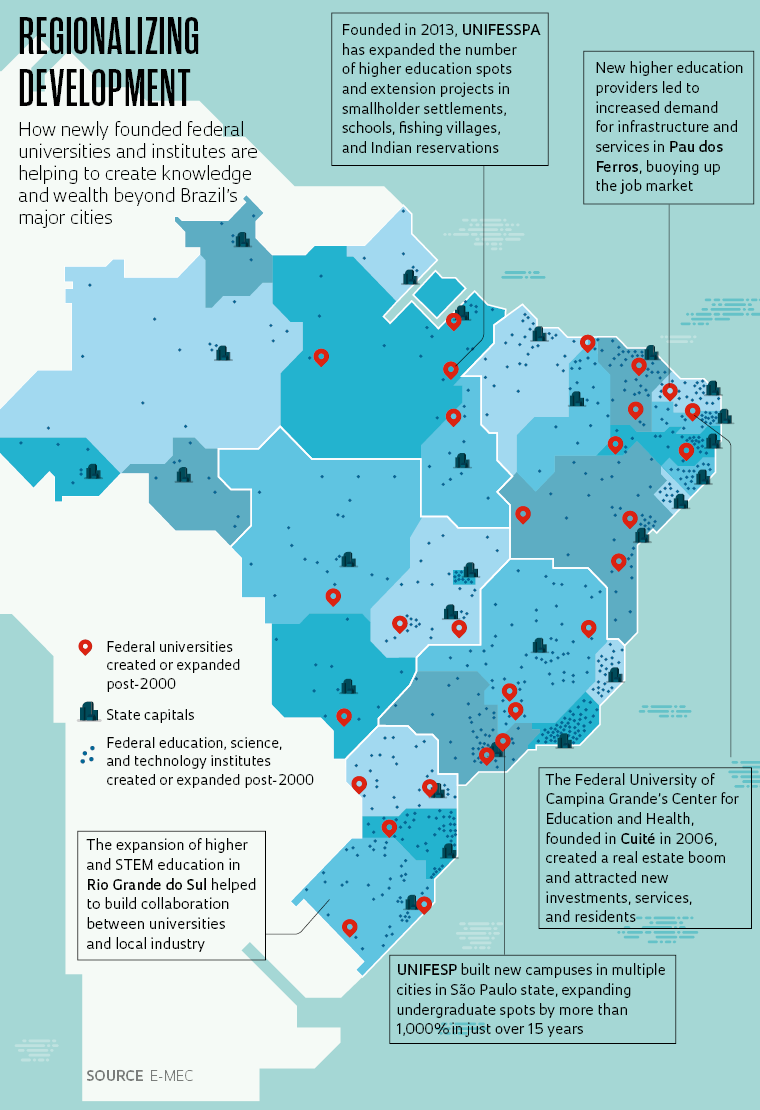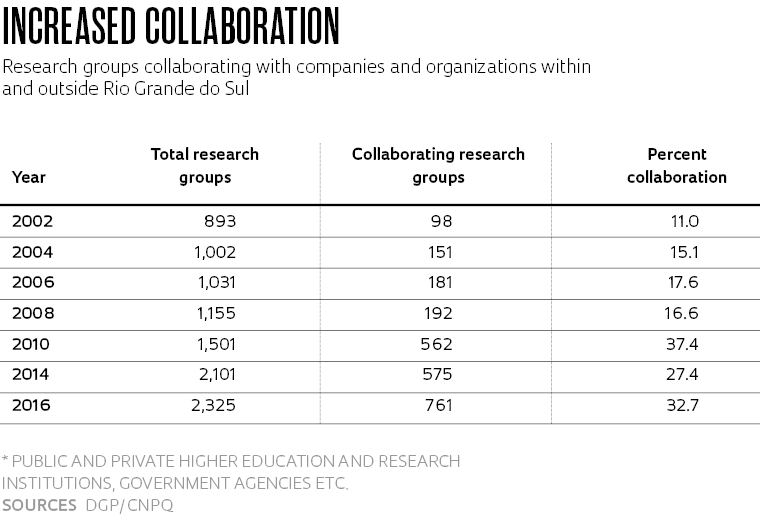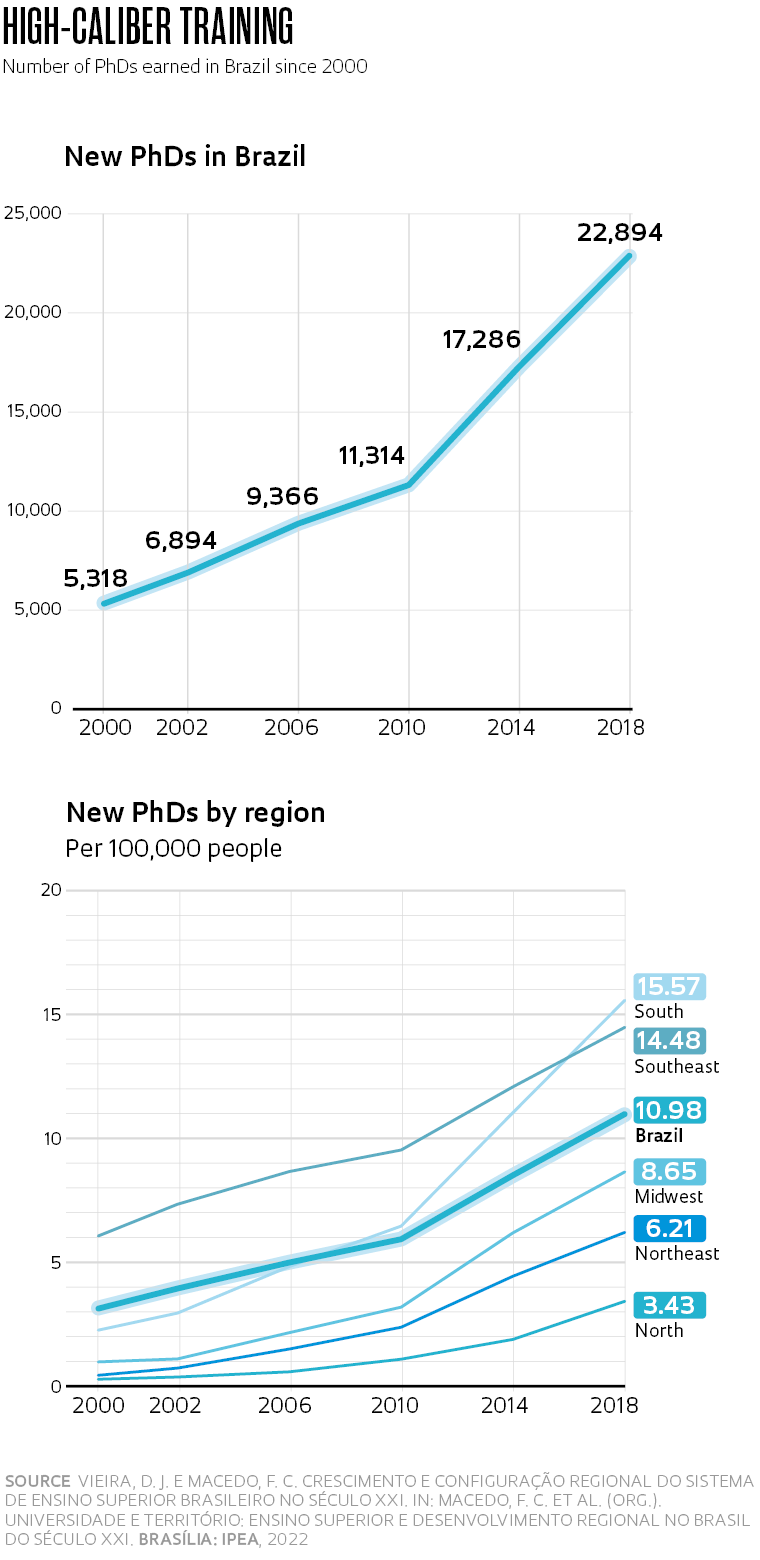In the last two decades, the federal government has created 27 universities, 19 public higher education institutions, and dozens of branch campuses of existing institutions, many of them in minor cities throughout Brazil. Now, researchers are evaluating the impacts on economic and regional development from the outward expansion of higher education providers. Recent studies have shown that, while progress has been stuttered, these efforts have had a measurable impact on local development by helping to create knowledge and wealth.
Pau dos Ferros, a town with a population of 30,000 people in Rio Grande do Norte, is a case in point. In 1976 the State University of Rio Grande do Norte (UERN) established a local campus offering programs in the humanities and social and health sciences. The town’s academic community later expanded to include a federal higher education institute in 2009, and a newly built campus of the Federal Semiarid Rural University (UFERSA), in 2012. Today, the city also hosts private institutions such as Anhanguera and Faculdade Evolução Alto Oeste Potiguar (FACEP), attracting students from both Rio Grande do Norte and its neighboring states of Paraíba and Ceará.
Ronie Cleber de Souza, at the UERN Department of Economics, notes that the city and its services gradually expanded to accommodate a growing contingent of professors, staff, and students—in 2018, the UERN campus had 1,156 undergraduate and 265 graduate students. The real-estate market boomed—10 new neighborhoods were created from 2010 to 2015—while the local job market expanded with formal employment rising by a significant 102.5% from 2000 to 2010, far outstripping the number of jobs supported by higher education institutions. “The share of public-sector jobs in formal employment dropped from 57% to 34% in the period, clearly denoting a virtuous cycle of job creation that decade,” says Souza, a coauthor of a survey published in Universidade e território – Ensino superior e desenvolvimento regional no Brasil do século XXI (Universities and regional development in twenty-first century Brazil), organized by the Institute of Applied Economic Research (IPEA). Launched in May, the book is a compilation of papers by researchers in different fields and institutions throughout the country, exploring how the expansion of higher education into small-town Brazil has driven local economic development and improved social welfare.
The most prominent example of this is perhaps Rio Grande do Sul. From 2003 to 2015, several new federal universities and institutes, and 20 new branch campuses of existing institutions, were established in the state, many of them in cities with less than 100,000 people. A study led by economist Ana Lúcia Tatsch at UFRGS found that, as intended, the expansion created a growing offering of undergraduate and graduate STEM programs in underdeveloped regions of the state, especially in the fields of crop science and veterinary science. “This makes sense, as agriculture is one of the state’s leading industries,” notes the researcher, who authored one of the 16 papers in the IPEA series.

As one of the effects from the expansion, the number of graduate programs in Rio Grande do Sul grew from 102 to 239, while the number of research groups registered with the Brazilian National Council for Scientific and Technological Development (CNPq) went from 1,869 to 3,601 between 2002 and 2016. According to the researchers, their data show that the branching out of higher and STEM education in the state has helped to establish a research ecosystem in areas outside major cities. The impact on productivity and innovation in the state can be measured by the number of university collaborations with industry, both locally and nationally. In 2002, 11% of 893 research groups at federal universities said they had collaborations with companies, public and private education and research institutions, government agencies, and other organizations. In 2016, 33% of 2,325 research groups said they had links to external partners.
Another study showed that young institutions had proportionally more local partners. Incumbent research groups had 1,543 collaborations in 2016, 826 (53%) of them with in-state organizations and 717 (46%) across state borders. Younger institutions collaborated with 164 (73%) partners in Rio Grande do Sul and 60 (27%) in other states. Economist Iago Luiz da Silva, one of the authors of the survey, believes this can be explained by the fact that new universities were largely created for the specific purpose of promoting regional development.
The survey results in Rio Grande do Sul are consistent with trends seen in other regions. “Companies seeking solutions to more complex problems will typically work with well-established, world-class research groups in major universities,” says Renato Garcia of the University of Campinas (UNICAMP) Institute of Economics, who did not collaborate on the IPEA series—Garcia has extensively researched the regional impact of higher-education institutions in Brazil. “Not uncommonly, these collaborations are created by alumni who are hired to work in R&D [research and development] departments at partner companies,” says Eduardo da Motta e Albuquerque, an economics professor at the Federal University of Minas Gerais (UFMG) and a researcher at the Center for Regional Development and Planning (CEDEPLAR). The literature shows that “the ability that research groups have to develop skilled human resources and produce high-impact research attracts companies seeking partners to address real-world problems.”
One of the leading examples of this is São Carlos, a city 230 kilometers from São Paulo. Beginning in the 1950s, the city became home to a growing number of education and research institutions, starting with the University of São Paulo at São Carlos School of Engineering (EESC-USP), founded in 1953, followed in the early 1970s by the Federal University of São Carlos (UFSCar) and two new USP units: the São Carlos Institute of Mathematical Sciences and the São Carlos Institute of Physics and Chemistry, which was later split into two separate institutions, in 1994. One year prior, EMBRAPA’s Agricultural Instrumentation chapter had also located in the region. These investments turned the city into a science and technology hub that has helped to develop a large pool of skilled human resources, especially in fields such as engineering and earth sciences. A survey by the São Carlos Institute of Chemistry found that the city has one PhD for every 100 people, around 10 times more than the national average. Many PhDs are hired by the roughly 200 tech companies that have located in the area in recent years so they are strategically close to academic centers of excellence; some companies have even been founded by alumni.

Another prominent example is Santa Rita do Sapucaí, in Minas Gerais, which in 1959 built the first electronics trade school in Latin America. “The institution has since trained a large contingent of electronics and telecommunications technicians, helping to address a manpower barrier to the development of the industry,” notes Renato Garcia, who has researched the factors underlying the thriving electronics industry in the region. Several companies, he notes, were started by alumni. This continued with the arrival of the National Telecommunications Institute in 1965, offering higher education programs in telecommunications to develop the skills and expertise demanded by companies such as Telemig, Dentel, and Telebras.
Garcia believes that the economic impacts from the recent expansion of some federal institutions would have been greater if coupled with policies to create industrial clusters that could absorb graduates in host regions. “In Rio Grande do Sul, federal universities branched out into areas with relatively well-established industrial districts that responded well to the stimulus,” he notes. “In regions without a significant industrial presence, the strategy for driving innovation and regional development has been to use a bottom-up approach, starting with local skills building.” Another challenge, says Garcia, has been Brazil’s recent science funding crunch and its effects on the development of these institutions (see Pesquisa FAPESP issue nº 304).
But before advancing regional development, the primary goal in expanding public universities was to increase Brazil’s offering of higher education spots. Indeed, the number of enrollments at federal higher education institutions rose from 505,000 in 2001 to 1.2 million in 2020, according to data from the Anísio Teixeira National Institute for Educational Studies and Research (INEP). This was one of the reasons that led the Federal University of São Paulo (UNIFESP) to create new campuses in cities like Diadema, Osasco, Guarulhos, and São José dos Campos beginning in 2004, expanding undergraduate spots by more than 1,000% in just over 15 years. In 2005 the university had five undergraduate programs at its campus in São Paulo City, home to its prestigious São Paulo School of Medicine. It now offers 52 programs with more than 13,000 students enrolled.
New campuses will naturally have a positive impact on the local economy. In Cuité, a city of 20,000 people in Brazil’s northeastern state of Paraíba, the founding of the Federal University of Campina Grande’s Center for Education and Health (CES-UFCG) in 2006 drove up the real estate market and attracted new investments, services, and residents. “At least five private institutions have since located in the city, offering primary, trade, and higher education,” notes Josias de Castro Galvão, a geographer at the Center for Exact and Natural Sciences at the Federal University of Paraíba (UFPB), who discusses the regional impacts from the new center in a 2020 paper published as part of a series produced by researchers at UFPB and the State University of Rio de Janeiro.

